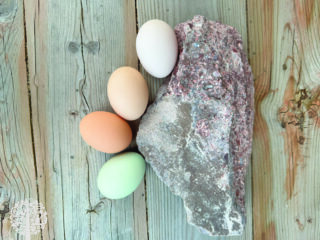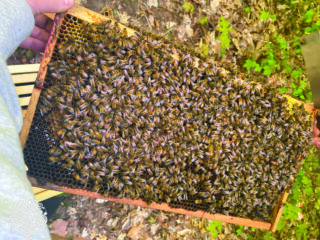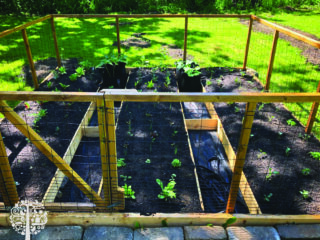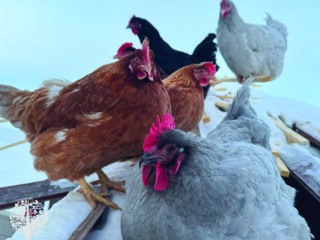Fertility without fertilizer. Food without fossil fuels. Hope without hierarchy. Welcome to the regenerative movement.

Whether in a 4th-floor apartment or your own back forty, regenerative gardening – one of 2025’s most searched keywords in the gardening world – is all about healing relationships with the land, our bodies, and each other.
Regenerative is so much more than a buzzword. It is the foundation upon which our future will be built. With the destruction of ecosystems and deterioration of the soil microbiome, regenerative practices truly are humanity’s last resort for repatriation.
Nature simply cannot work with soil as an inert medium.
Growing monocrops with salts and toxic pesticides has efficiently produced food on mass for a growing global population. Though you’ve seen it, driving across the Prairies with wheat and rapeseed as far as the eye can see, the agricultural salt residue is visible on the land. And for good reason!
I’m not poo-pooing our ability to feed people. I’m just saying there may be a better way to do it that doesn’t involve run-off (but it does involve poop).

What Does Regenerative Gardening Do?
Regenerative gardening works to regenerate the soil and close linear systems by creating fertile soil. The playbook is something like this: compost, sequester carbon, revive microbes, heal the soil, and regenerate us all through nourishing practices.
Repurposing waste, collecting rainwater, saving seeds, and producing a portion of our own food is a massive revolutionary act that helps better the planet, reclaim our agency, and even decentralize power from the few global conglomerates that regulate agribusiness.
This isn’t a trend. It’s a revolution disguised as a tomato patch. It’s getting stoned and crafty. It’s carving out time and space for simple activities that literally anyone can do.
Yesterday morning, I fed my chickens dried-out papaya with expired plain yogurt and a handful of flax meal.
They annihilated it! We read that feeding chickens yogurt can increase egg production. With three dogs running around, we need all the eggs we can get! Plus, we feed the eggshells back to the birds or amend the soil with them. The solution is right in front of our faces, and everyone can participate.

Regenerative Gardening: Start Wherever You Are
I remember the crippling anxiety I had at the start of the pandemic. I felt powerless to sustain myself and had no clue how to garden; it wasn’t a skill I was taught as a kid. But I had just started growing cannabis for the first time after a crash course at a legacy grow in the Shuswap.
I started studying an online horticulture program, specializing in cannabis production. And even though I wasn’t in a location conducive to farming, I knew that putting time and effort into that course every day was something I could do in that moment to work towards my homesteading goal of living within a dedicated community.
What did I learn from that course? It was certainly helpful, especially having my parents’ urban backyard and my basement grow-op to explore. And as a writer, distance education is an environment that works for me. But looking back, it wasn’t even necessary!
YouTube University
Gardening is one of those areas where your degree from YouTube University will do wonders. Just plug in your specific conditions – your niche – and pull out a notebook. The success is tangible, so it doesn’t matter where the knowledge came from.
I suggest getting practice through volunteering in your community. Or get a part-time job working in the field. I planted strawberries one summer on a commercial farm in Ontario, and then harvested hemp that fall on Vancouver Island. I did some landscaping on a goat farm in Nanaimo, and I threw hammers at my cousin’s Cowichan Valley homestead in exchange for homegrown produce and hard apple cider.
You can learn from books, AI, and the internet. You can also learn from the people around you. Align with them! Like anything, refining your craft takes practice.

Practical Applications for Regenerative Growing
Close the loop, even in small spaces:
Most scraps and waste can be repurposed for the garden by helping build organic matter (humus). Use worm bins, bokashi kitchen composters, and aged manure from livestock. When resources are scarce, this is a lifesaver!
Water is gold, harvest it:
Rain barrels, greywater systems, and ponds. Rural growers use waiting pools to water crops. Tiny houses and urban dwellers can recapture shower or laundry water to gently filter and use in the garden (if we’re going regenerative, we’re ditching Dawn!).
Grow in community, not isolation:
Join or build local co-operatives, garden shares, and barter networks. Swap your preserves for seedlings and create skill-sharing hubs with regular community meets. Get involved and raise your voice in associations in order to be heard! Lobby for community gardens if there are none.

Supercharge soil with biochar and compost tea:
You can create your own biochar from garden waste or fallen trees. Biochar is a low-tech but high-impact method for plant fertility (I once saved my garden using biochar and barley mulch). Its negative charge holds water and nutrients, feeds microbes, and locks carbon into your soil.
Grow diverse crops:
Mimic nature by practicing polyculture and companion planting. The diversity of this practice is similar to that of a natural ecosystem, promoting healthier plants that are more resistant to pests and diseases. A balanced garden, beyond its beauty, will have higher yields. Try the infamous three sisters: corn, beans, and squash.
Build soil from the top down:
The science behind no-till holds water. Try sheet mulching, compost layering, and cover crops instead. This way, you’ll preserve fungal networks, suppress weeds, and you won’t disturb the soil microbiome, leading to long-term fertility.
Plant once, harvest for years:
Sounds like a fairy tale, doesn’t it? It doesn’t have to be! Part of the legacy I intend to pass on is the orchard I plant or the medicinal shrubs I tend as my apothecary garden. Establish perennial food forests with berries, mushrooms, and herbs. Perennial plants are the heart of regeneration.
Save seeds, save culture:
You don’t need a degree to breed plants. You can simply collect seeds from your strongest heirlooms each year. This mindful act contributes to the selection of plants for future generations. By collecting, sharing, and replanting each year, you’re supporting local adaptation, food sovereignty, and even resisting corporate control.
Design for diversity, invite pollinators and wildlife:
One of the tragedies of modern agriculture is the separation of plants and animals. Never underestimate the power of a couple of rabbits at home. Integrate chickens, bees, or other native insects into your plot. Create hedgerows, pollinator patches, or rotating livestock systems to build healthy, interconnected ecosystems that help balance, fertilize, and protect your plants.
Let regeneration be a daily practice:
A regenerative mindset will become routine, like feeding the cat or going to the gym. Carve out time to tend your worm bins, prune your patio plants, and forage for berries. It’s a lot more work than dialing Uber Eats, but the reward is a far cry from a fleeting dopamine hit. Regenerative rewards last lifetimes, no matter the scale you’re working on. The mindset is the same: think cyclically, build for resilience, and relish the joy in nurturing life itself!
